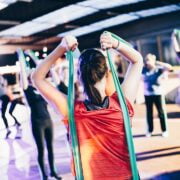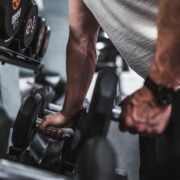
How To Do Good Mornings
Good mornings are an essential exercise in any fitness routine. They target the muscles in your lower back, glutes, and hamstrings, making them a great exercise for building strength and stability in your posterior chain. In this article, we will explore the basics of good mornings, how to perform them correctly, common mistakes to avoid, and how to modify them for different fitness levels. Whether you are a beginner or an advanced fitness enthusiast, incorporating good mornings into your workout routine can have numerous benefits.
Key Takeaways
- Good mornings are a compound exercise that primarily targets the glutes, hamstrings, and lower back.
- It’s important to warm up and stretch before performing good mornings to prevent injury.
- Proper form is crucial for good mornings, including keeping your back straight and hinging at the hips.
- Common mistakes to avoid include rounding your back, using too much weight, and not engaging your core.
- To increase the intensity of your good mornings, you can add weight, vary the tempo, or perform single-leg variations.
Understanding the Basics of Good Mornings
Good mornings are a compound exercise that involves bending forward at the hips while keeping your back straight and your core engaged. The movement mimics the motion of bending forward to pick something up from the ground. By performing this exercise, you engage several muscles in your body, including the erector spinae (lower back), gluteus maximus (glutes), and hamstrings.
The benefits of good mornings extend beyond just targeting these specific muscle groups. They also help improve your posture, increase hip mobility, and strengthen your core. Additionally, good mornings can enhance your overall athletic performance by improving your ability to generate power from your lower body.
Preparing Your Body for Good Mornings
Before diving into good mornings, it is crucial to warm up your body and prepare it for the exercise. This will help prevent injuries and ensure that you get the most out of your workout.
Start with some light cardio exercises such as jogging or jumping jacks to increase blood flow and raise your heart rate. This will warm up your muscles and prepare them for more intense movements.
After cardio, perform dynamic stretches that target the muscles you will be working during good mornings. These stretches should involve movements that mimic the exercise itself, such as hip circles or leg swings. This will help loosen up your hips and hamstrings, allowing for a greater range of motion during the exercise.
Step-by-Step Guide to Performing Good Mornings
To perform good mornings correctly, follow these steps:
1. Stand with your feet shoulder-width apart and your toes pointing slightly outward.
2. Place your hands behind your head, with your elbows pointing out to the sides.
3. Engage your core and keep your back straight throughout the exercise.
4. Slowly bend forward at the hips, pushing your glutes back as if you are trying to touch your toes.
5. Lower your upper body until it is parallel to the ground or until you feel a stretch in your hamstrings.
6. Pause for a moment, then slowly return to the starting position by squeezing your glutes and pushing your hips forward.
It is important to maintain proper form and technique during good mornings to avoid injury. Keep your back straight and avoid rounding or arching it. Focus on hinging at the hips rather than bending at the waist. Start with lighter weights or just bodyweight until you feel comfortable with the movement.
Common Mistakes to Avoid While Doing Good Mornings
While good mornings can be a highly effective exercise, there are some common mistakes that people make when performing them. These mistakes can lead to injuries or prevent you from getting the full benefits of the exercise.
One common mistake is rounding or arching the back during the movement. This puts unnecessary strain on the spine and can lead to lower back pain or injury. To avoid this, focus on keeping your back straight and engaging your core throughout the exercise.
Another mistake is using too much weight too soon. Good mornings are a challenging exercise, and it is important to start with lighter weights or just bodyweight until you have mastered the proper form and technique. Using too much weight can compromise your form and increase the risk of injury.
Tips to Increase the Intensity of Your Good Mornings
Once you have mastered the basic form of good mornings, there are several ways to increase the intensity of the exercise and make it more challenging.
One way to increase the intensity is by adding resistance. This can be done by holding a dumbbell, kettlebell, or barbell across your upper back or in front of your chest. Start with a lighter weight and gradually increase as you get stronger.
Another way to make good mornings more challenging is by performing them on an unstable surface, such as a Bosu ball or balance board. This forces your muscles to work harder to stabilize your body during the exercise.
How to Incorporate Good Mornings into Your Workout Routine
To incorporate good mornings into your workout routine, it is important to determine how often you should perform them and what other exercises to pair them with.
For beginners, it is recommended to start with 2-3 sets of 8-10 repetitions, 2-3 times per week. As you become more comfortable with the exercise, you can increase the number of sets and repetitions.
Good mornings can be paired with other exercises that target the same muscle groups, such as deadlifts or hip thrusts. This will help create a well-rounded lower body workout and maximize your results.
Benefits of Adding Good Mornings to Your Fitness Regime
Adding good mornings to your fitness regime can have numerous benefits for your overall fitness and specific fitness goals.
Firstly, good mornings help improve your posture by strengthening the muscles in your lower back and core. This can help alleviate back pain and prevent future injuries.
Secondly, good mornings increase hip mobility by stretching and strengthening the muscles in your hips and hamstrings. This can improve your range of motion in other exercises and daily activities.
Lastly, good mornings can help with specific fitness goals such as building strength and power in your lower body. By targeting the glutes, hamstrings, and lower back, they can enhance your athletic performance and improve your ability to generate power from your lower body.
Good Mornings vs. Other Glute Exercises: Which is Better?
While good mornings are a highly effective exercise for targeting the glutes, hamstrings, and lower back, there are other exercises that can also provide similar benefits. It is important to understand the pros and cons of each exercise to determine which one is best for you.
One exercise that is often compared to good mornings is the deadlift. While both exercises target similar muscle groups, the deadlift involves lifting a heavier weight off the ground, making it more challenging and requiring more overall strength. However, good mornings specifically target the glutes and hamstrings, making them a great exercise for building strength and stability in those areas.
Another exercise that targets the glutes is the hip thrust. This exercise involves lying on your back with your knees bent and lifting your hips off the ground. The hip thrust specifically targets the glutes and can be a great addition to your lower body workout routine.
Ultimately, the best exercise for you will depend on your specific fitness goals and preferences. It is recommended to incorporate a variety of exercises into your routine to target all muscle groups effectively.
How to Modify Good Mornings for Different Fitness Levels
Good mornings can be modified to accommodate different fitness levels, whether you are a beginner or an advanced fitness enthusiast.
For beginners, it is important to start with lighter weights or just bodyweight until you have mastered the proper form and technique. Focus on maintaining proper form throughout the exercise and gradually increase the weight as you get stronger.
For advanced fitness levels, you can increase the intensity of good mornings by using heavier weights or performing them on an unstable surface. This will challenge your muscles even more and help you continue to progress in your fitness journey.
Frequently Asked Questions About Good Mornings Answered
1. Are good mornings safe for everyone?
Good mornings can be safe for most people when performed with proper form and technique. However, if you have a history of lower back or hip injuries, it is recommended to consult with a healthcare professional before attempting this exercise.
2. Can I do good mornings if I have lower back pain?
If you have lower back pain, it is important to consult with a healthcare professional before attempting good mornings. They can assess your condition and provide guidance on whether this exercise is appropriate for you.
3. How long does it take to see results from doing good mornings?
The time it takes to see results from doing good mornings will vary depending on various factors such as your current fitness level, frequency of workouts, and nutrition. Consistency is key, and with regular practice, you can expect to see improvements in strength and muscle definition within a few weeks.
Incorporating good mornings into your fitness routine can have numerous benefits for your overall fitness and specific fitness goals. By targeting the glutes, hamstrings, and lower back, good mornings help improve posture, increase hip mobility, and build strength and stability in your posterior chain. Whether you are a beginner or an advanced fitness enthusiast, adding good mornings to your workout routine can help you achieve your fitness goals and enhance your overall athletic performance. So why not give them a try and experience the benefits for yourself?
If you’re looking to enhance your morning routine and start your day on a positive note, you might find this article from Wave Magnets interesting. They provide valuable insights on how to make the most out of your mornings and set the tone for a productive day ahead. From tips on creating a morning ritual to incorporating mindfulness practices, this article offers practical advice for optimizing your mornings. Check it out here for some inspiration on how to kickstart your day with intention and purpose.
FAQs
What are good mornings?
Good mornings are a weightlifting exercise that targets the lower back, glutes, and hamstrings.
What equipment do I need to do good mornings?
To do good mornings, you will need a barbell and weights. You may also want to use a squat rack or power rack for safety.
How do I perform good mornings?
To perform good mornings, start by placing a barbell across your shoulders behind your neck. Stand with your feet shoulder-width apart and your knees slightly bent. Keeping your back straight, hinge forward at the hips until your torso is parallel to the ground. Return to the starting position by squeezing your glutes and pushing your hips forward.
What are the benefits of doing good mornings?
Good mornings can help strengthen your lower back, glutes, and hamstrings. They can also improve your posture and help prevent lower back pain.
Are there any risks associated with doing good mornings?
Like any weightlifting exercise, there is a risk of injury if good mornings are not performed correctly. It is important to use proper form and start with a light weight until you are comfortable with the movement. If you have any pre-existing lower back or hip injuries, you should consult with a doctor before attempting good mornings.


















